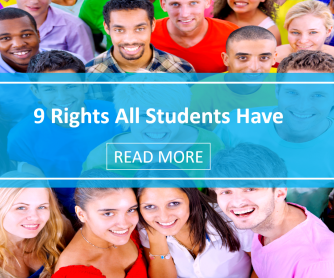
The state of education varies by country. In some countries, all students receive a high-quality education and are surrounded by individuals (teachers, parents, government officials) who put a high value on learning. In other countries, the quality of education a student receives can vary by state, county, city, district, or even race and social class. Regardless of what the state of education looks like where a student lives, there are some fundamental rights that all students have when it comes to education. Keeping these rights in mind can help teachers and administrators ensure all students receive the education they deserve.
1. The Right to Learn
All students have the right to learn. This means they should be provided with the opportunity to attend school or participate in another learning environment, and be given the materials and information they need to gain knowledge. Even students with severe disabilities and those who have extensive discipline problems deserve the opportunity to learn; it just may take more time and resources to make that happen. Adults should be advocates for students' right to learn and fight back against laws, policies, and procedures that prevent this from happening. Teachers and administrators must also work to ensure that students can work in an environment that is conducive to learning.
2. The Right to a Qualified Teacher
In some areas of the world, teacher tenure laws and other corrupt systems keep ineffective teachers in the classroom. Administrators should work to remove those teachers from the classroom and provide training to help teachers improve their skills so that all students can have access to highly qualified teachers. Even though it takes a lot of time, teachers should work to continually improve their knowledge and teaching strategies and reflect upon their practice to ensure that they're being as effective as they can. Even veteran teachers need to reflect upon their practice from time to time.
3. The Right to Fair Assessment
One of the biggest complaints against standardized tests is that they do not offer a fair assessment of student learning. Many tests are biased toward wealthier students who have a store of crucial background knowledge that they can use to answer questions on the test. Rather than using a standard assessment, educators must consider the knowledge of their specific students and develop assessments that help them demonstrate what they have learned.
4. The Right to Be Seen (and Taught) as Individuals
Similarly, all students come to the classroom with a different set of skills and abilities. Some students are great writers. Others are great at math. Some have trouble remembering information that is presented to them in an auditory manner. Others have trouble sitting still for a long time. Even though it's difficult to plan individualized instruction (particularly in large classes), teachers should work to see all students as they individuals that they are and provide resources or activities to help them meet their potential.
5. The Right to Receive Support
Whether students have learning or behavioral difficulties or simply need some extra help, they have the right to receive support in the classroom. This may come in the form of an IEP/ILP with guidelines for teachers to follow. It may involve tutoring students who need extra help or allowing students to retake a test after they've reviewed the material again. Sometimes support will come in the form of a teacher who is willing to sit down and let a student share about struggles at home or other problems they're facing. Students should feel like they can go to the adults in the school to receive help with whatever issues they may be experiencing.
6. The Right to be Respected for their Differences
Students come into the classroom with all kinds of differences. They are different races. They have different socio-economic statuses. They have different interests and viewpoints. Teachers should not put students down or treat them negatively because of these differences and they should not allow other students to bully them or put them down for these differences either. Instead, teachers should create a classroom environment that recognizes the value of different perspectives.
7. The Right to Be Treated with Kindness
Bullying has become a major problem in schools around the world and social media makes it easy for students to post negative messages and spread rumors. Adults can fight against this by modeling kindness in their speech and actions, as well as providing opportunities for students to show kindness to one other. There's never an excuse to not be kind, even if you're dealing with a frustrating situation.
8. The Right to Express Themselves Freely
In a classroom where students feel respected and are treated with kindness, they may feel more comfortable expressing themselves. School should be a place where students can speak up and have the freedom to give the wrong answer or make a mistake without being ridiculed. This free expression doesn't just come in through Q&A or review sessions. It also applies to writing, art, drama, and other activities where students put themselves and their opinions out into the world. Of course, teachers should help students understand what types of expression are appropriate. For example, threatening violenace against a teacher or student is not allowed because it violates other rights students have.
9. The Right to Feel Safe
School should be a place where students feel safe. This is true in Main Street USA and in war-torn Iraq or Afghanistan. Teachers and administrators will not be able to protect every tragedy, but they should work to create a space where students feel comfortable taking risks, know that they will be accepted, and understand that the adults in the classroom are willing to protect them.
P.S. If you enjoyed this article, please help spread it by clicking one of those sharing buttons below. And if you are interested in more, you should follow our Facebook page where we share more about creative, non-boring ways to teach English.








